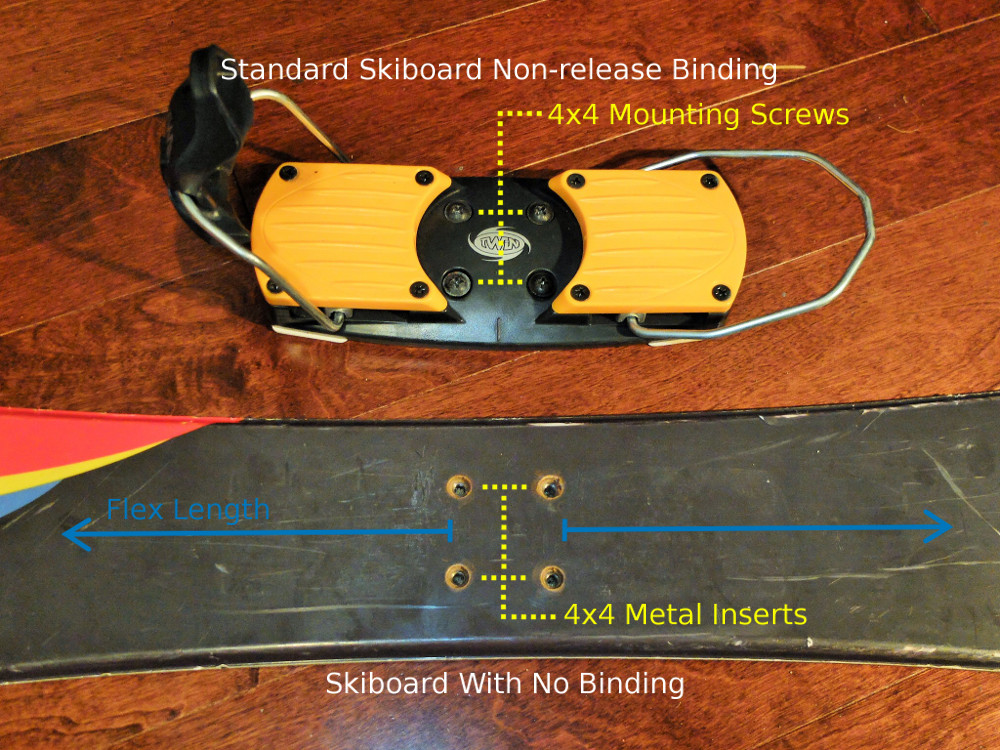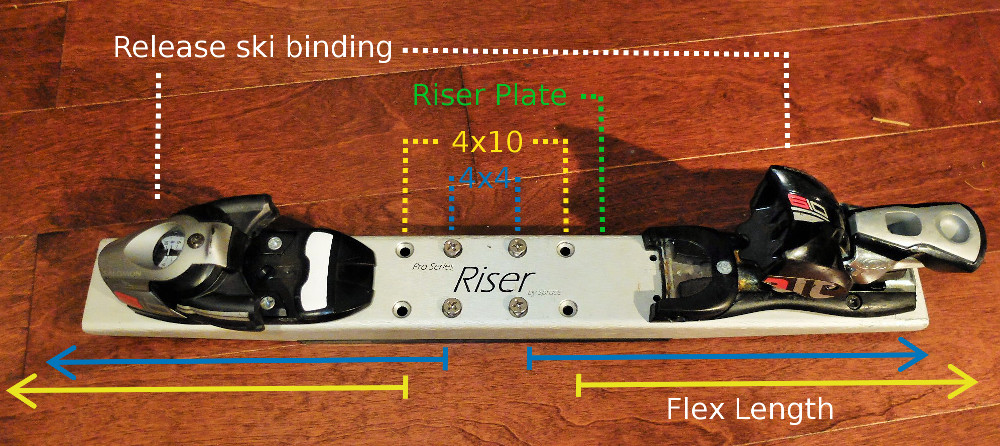In collaboration with Skiboarding Riders’ Choice Awards, we put together a comprehensive guide to all that is skiboard bindings!
There are many skiboard binding systems and binding options and it can get very confusing for those unfamiliar. If you are a first time buyer, you will most likely buy skiboards and bindings that will come pre mounted for you, however many people will use more than one set of skiboards for different conditions, and want the ability to swap bindings from one set to the next. Binding lifetime is also generally longer than skiboard lifetime, so think down the road if you are going to be buying a new pair of skiboards, you may be able to re-use your original bindings. Ask yourself these questions before buying skiboards and bindings:
- Do I want the best performance or more affordable deal?
- Do I want to easily move bindings from one set of skiboards to another?
- Do I want the added safety of releasable bindings?
- Do you want to use hard shell skiboots, or soft shell snowboard boots.
Not sure how answer? No worries, it should be clear by the end. There are four ways bindings can attach to you skiboards, 4×4, 4×10, direct mount, and 8-hole. Let’s look at them in detail.
4×4 binding system
Long time standard for skiboards borrowed from snowboarding, this system uses 4 metal inserts built into the skiboard in a square pattern set 4 cm apart. This options gives a better overall performance as it gives a longer flex length to the skiboards when compared to other options. Offers the ability to quickly and easily install or remove bindings simply with a screw driver.
This mounting system has the most binding options, including the long time standard non-releasable skiboard bindings which most skiboard brands offer. These can be used with hard shell ski boots, and also the less commonly used hard shell snowboard boots. Standard skiboard bindings do not release during a fall. It is generally safe to use non-releasable bindings with skiboards under 110cm, (depending on the skiboarder’s height) as the reduced length of skiboards reduces the risk of injury due to physics law of levers.
Most snowboard bindings can also be installed on 4×4 skiboards, however, a riser is usually needed to lift the bindings up as snowboard bindings for soft boots are generally wider than most skiboards. Without a riser, the bindings would catch in the snow as you turn. Most riders have found that the best results for skiboarding in snowboard boots are a stiff snowboard boot coupled with a snowboard binding that includes three modifications: 1. a riser, 2. a winged highback to provide lateral support and 3. a wide third strap attached to the winged highback. A variety of commercial converted snowboard bindings or conversion kits are currently available for purchase from online retailers.
Releasable bindings are heavier than non-release bindings, but offer more safety as they release during a fall. They require a simple step in motion to be attached to your boot. They are the same as found on skis in most cases. Spruce, Eman, Twoowt, and Mantrax offer a 4×4 releasable binding option in the form of a kit that includes releasable ski bindings mounted on a riser plate which is then screwed into the skiboards via the 4×4 system. Obviously, these require hard shell ski boots. These Riser kits are heavier than other options.
Brands using the 4×4 system: Bluemoris, Eman, FATBlades, GPO, GR, Mantrax, RVL8, Snowjam/540, Spruce, Strictly, Summit, Twoowt.
+ Lots of binding options
+ Best performance
+ Easy to install and remove bindings
+ Safety in case of fall (releasable binding option)
– Heavier due to required riser plate (releasable binding option)
4×10 binding system
This system was created by Spruce Ski for their longboard skiboards, skiboards longer than 110cm. It is not recommended to use longboard skiboards without releasable ski bindings, and to avoid anyone from installing non-releasable bindings onto their skiboards, Spruce created a system similar to 4×4, but spaced 10 cm apart length wise, giving the advantages of the 4×4 pattern without the possibility of installing non-releasable bindings. Their Riser Releasable Binding kits can be mounted on both 4×4 and 4×10 skiboards. Spruce is currently the only company to offer skiboards and bindings for this option.
+ increased performance
+ easy to install and remove bindings
+ safety in case of fall
– heavier due to required riser plate
Direct Mount bindings
A sometimes contested option, direct mount requires drilling holes into the skiboards and attaching releasable ski bindings directly into the skiboard with screws such is the standard for the regular length ski industry. Most often they will come pre-mounted from manufacturers. Not all skiboards can be direct mounted, as it can effect the structural integrity of the skiboards. Some skiboards can be direct mounted thanks to a reinforcement plate build into the skiboard, or stronger thicker cores. This adds some weight to the skiboards themselves, although the bindings themselves are lighter since there is no need for a riser plate.
Skiboards that can be Direct Mount have reduced the flex length of the skiboards, reducing performance, however some people will argue that the difference is minimal and some bindings are built on rails to increase flexibility.
Another issue is with limited ability to reinstall and remove bindings. It is possible, but generally not recommended to remove and reinstall direct mounted bindings too often. Sometimes if a different size boot is used, the holes must be redrilled in a different location, affecting the structural integrity of the skiboards. It is possible, with heavy modification, to install metal inserts into skiboards for direct mount, giving the ability to easily remove bindings, however this requires a trained ski binding technician.
This system is currently the most popular with big ski brands, who generally offer short ski options targeted to beginners. These often have bindings that can fit all boot sizes with no remounting required. Some models using this system are sometimes referred to as snowblades or skiblades.
Brands using this system: GR, SnowJam/540, Bluemoris, Spruce, Summit, big name ski brands, knock-off brands.
+ Lighter weight releasable binding option
+ Sometimes more affordable than 4×4 or 4×10 releasable options
+ Safety in case of fall
– Reduced flexibility and performance
– Added weight to skiboards due to reinforced mounting area
– Cannot be easily installed or removed
– May not be easily adjustable for different boot sizes
8-hole non-releasable binding system
Loathed by many in the skiboard community. Usually offered on budget skiboards or short skis, and using 8 screws directly mounted, or using metal inserts spanning the entire length of the binding. This limits the flexibility of the skiboard, reducing performance. Usually these bindings are made with low quality plastic. It is also near impossible find replacement bindings and very unlikely they can be swapped onto another set of skiboards. These bindings come premounted on skiboard, and are usually very affordable. There is also no releasable binding option for this system. These more often than other options have easy tool-less adjustment for different boot sizes. Some models using this system are often referred to as snowblades or skiblades.
Brands using this system: GPO, Mantrax, SnowJam/540, older big ski brand models, knock-off brands
+ Lowest price option
+ Easy tool-less adjustment
– Often made from low quality materials
– Reduced flexibility and performance
– No after market options
– Often paired with lower quality skiboards
Another option that cannot be easily classified are the releasable skiboard bindings offered by GPO, and also Eman. They look like standard skiboarding bindings, but the top half can be released from a secondary plate direct mounted onto the skiboards. These offer a light weight releasable option, however lowered performance due to the direct mount.
So there you have it, all your skiboard binding options. Its important to note that skiboards using the higher performing metal insert options, 4×4 and 4×10, are almost exclusively available through online skiboard retailers, or limited specialty sport stores mostly in Russia and Japan.
Sport and ski stores will almost exclusively sell big brand skiboards or snowblades, generally marketed as beginner skis, and generally using lower quality 8-hole bindings or more recently direct mounted bindings.



